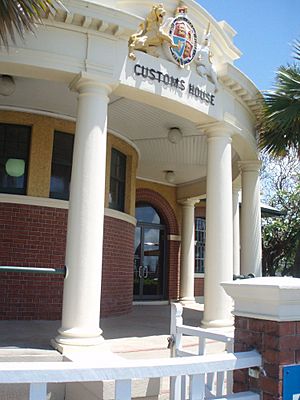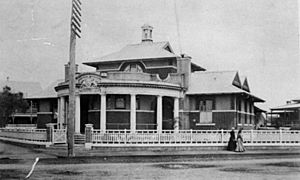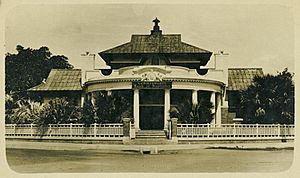Mackay Customs House facts for kids
Quick facts for kids Mackay Customs House |
|
|---|---|

Entrance to Mackay Customs House, 2010
|
|
| Location | 31 River Street, Mackay, Mackay Region, Queensland, Australia |
| Design period | 1900–1914 (early 20th century) |
| Built | 1902 |
| Architect | John Smith Murdoch (attributed) |
| Official name: Mackay Customs House | |
| Type | state heritage (built) |
| Designated | 7 February 2005 |
| Reference no. | 600669 |
| Significant period | 1900s, 1935 (fabric) 1900s-1920s (historical) |
| Significant components | trees/plantings, store – bond, fence/wall – perimeter, garage, customs house |
| Builders | MS Caskie |
| Lua error in Module:Location_map at line 420: attempt to index field 'wikibase' (a nil value). | |
The Mackay Customs House is a special old building in Mackay, Australia. It is listed on the Queensland Heritage Register, which means it's an important part of history. This building was finished in April 1902. It was designed by an architect named John Smith Murdoch and built by MS Caskie.
Contents
History of the Customs House
Early Days in Mackay
In 1860, John Mackay explored the area and named the Mackay River. This river was later renamed the Pioneer River. In 1862, the first settlers arrived and started a town called Port Mackay.
The government soon made the river mouth an official "Port of Entry." This meant ships could legally enter and bring goods. In 1863, John Tanner Baker became the first customs officer. He collected taxes on goods coming into the port.
Building the First Customs House
It quickly became clear that a proper building was needed for the customs office. In 1864, money was set aside for a new building. By 1865, a timber (wooden) Customs House was finished. It was located on a special piece of land for government buildings. This land overlooked the river.
Mackay Grows and Needs a New Building
Mackay grew quickly because of its port and the sugar industry. River Street became a busy area with wharves, warehouses, and hotels. The customs area included the Customs House and a "bond store." A bond store is a secure warehouse where imported goods are kept until taxes are paid.
By 1895, people in Mackay wanted a new, bigger Customs House. The old wooden one was too small. The government added a wooden extension, but people protested. They wanted a new brick building that was safer from fires.
Designing the New Customs House
The plans for a new brick building were made in 1900. The design is thought to be by John Smith Murdoch. He was a district architect for the Queensland Public Works Department. This department designed many beautiful public buildings in Queensland.
Murdoch also designed other Customs Houses in Queensland. Later, he worked for the Commonwealth Government. He helped plan Canberra and designed the first Parliament House.
The new Mackay Customs House was finished in April 1902. It was built with local bricks and had a metal roof. The old timber Customs House was moved next door. It became part of the Second Officer's Quarters.
Changes Over the Years
In 1921, the Commonwealth Bank rented the Customs House. The customs service moved back into the old timber building. Since then, the brick Customs House has been used by different government offices. Around 1935, a brick bond store was built on the site.
After a big cyclone in 1918, Mackay grew a lot in the 1920s and 1930s. A new bridge, the Forgan Bridge, was built nearby in 1938. This increased traffic in the area.
In 1939, a new, larger port opened in Mackay. The old river port slowly became less important. Today, only a few buildings from the old river port remain, including the Customs House. The building had some additions in 1969-70. In the late 1980s, it was restored to look more like its original design.
In 2004, the Customs House was sold to a financial company. They won an award for restoring the building. In 2020, a dental practice bought the building. They now run their dental surgery from this historic site.
What the Customs House Looks Like
The Mackay Customs House is a single-storey brick building. It is located where Sydney and River Streets meet. It faces the river mouth.
Inside the Building
The main part of the building is the Customs Office, also called the Long Room. In front, there is a curved public area with columns. Offices are on each side of the Long Room. At the back, there is an enclosed veranda with utility rooms and a strong room.
The inside has plaster walls and wooden doors and frames. The Long Room has a high ceiling with decorative metal and special windows. These windows let in light from above.
Outside the Building
The outside walls are made of red bricks. The roof is made of corrugated steel and has decorative wooden parts. The curved entrance has columns that support a decorated top section. In the middle, there is a raised wall with the Royal coat of arms. This shows it was a government building.
There are French doors with special glass panels leading into the public area. The owners have made some small changes, like replacing metal gates with glass doors.
Other Buildings on the Site
On one corner of the property is the old bond store. It is a rectangular brick building. At the back of the site, there is also a garage.
The property has a timber picket fence along both streets. There are palm trees, lawns, and concrete paths. There is also a car parking area at the back.
Why the Customs House is Important
The Mackay Customs House was added to the Queensland Heritage Register in 2005. It is important for several reasons:
Showing Queensland's History
This building was completed in 1902. It stands on the site of Mackay's first Customs House from 1865. People wanted a new brick building to show Mackay's success. The site has been used for customs services for over 130 years. It is one of the few remaining buildings from the old river port.
Showing What a Customs House Is Like
The Customs House was built for the new Australian government. It has a special architectural style from that time. This style was part of a search for a unique Australian identity. It shows the coat of arms on the front. Its main room, the Long Room, is a traditional part of a Customs House. The bond store is also still on the site. The building's outside and inside are mostly original.
Its Beautiful Design
The building's design is believed to be by JS Murdoch. He worked for the Queensland Works Department. This department designed many great public buildings. The Customs House shows great skill in its design. It combines a home-like feel with the formal look of government buildings. Murdoch later had a very successful career with the Australian government. He played a big part in planning early Canberra.



